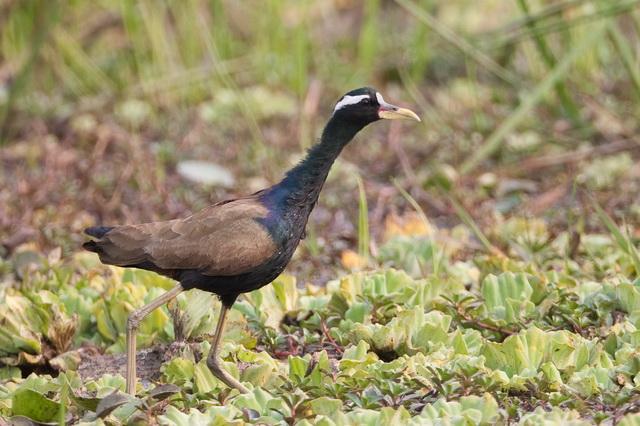Metopidius indicus
IUCN
LCBasic Information
Scientific classification
- name:Metopidius indicus
- Scientific Name:Metopidius indicus,Bronze-winged Jacana
- Outline:Wading birds
- Family:Charadriformes P.Charadriidae C.Pheasant
Vital signs
- length:28-31cm
- Weight:No textual research information is available
- lifetime:10-18 years or so
Feature
The body is similar to that of a water pheasant, with a lead-gray red frontal armor on the forehead, black neck and lower body, with metallic glow
Distribution and Habitat
It is found in tropical and subtropical regions of southern Asia. These include Bangladesh, Cambodia, China, India, Indonesia, Lao People's Democratic Republic, Malaysia, Myanmar, Nepal, Pakistan, Thailand and Viet Nam.
It is found in freshwater lakes, reservoirs and ponds rich in emergent or floating plants, and sometimes in wet grasslands and rice paddies.
Appearance
The copper-winged pheasant is similar in shape to the pheasant, but has a lead-gray red frontal armor on its forehead; The apex of the feather remains narrow and thin; There is no white on the wings. The head and neck are black, with a green metallic luster, and gradually turn dark purple to the upper back and shoulders, also with a metallic glow. A broad and long white brow line is known from above the eyes on either side of the back of the pillow. The back, wings and inner flight feathers are olive bronze, while the waist and tail coverings are maroon with a purple sheen. The tail feathers and undertail coverts are maroon. The underbody and underwing coverings are black with a green metallic sheen. The head is small. The iris is brown. The mouth is medium in length, relatively stiff, and slightly curved at the apex, yellow in color, red at the base and fleshy frontal plate above the mouth, near the forehead, and rounded at the posterior margin. The feet and toes are dark green, the w
Details
Bronze-winged Jacana is a small wading bird with no subspecies.

Copper-winged pheasant is a resident bird, active during the day, mostly alone, and often integrated in small groups during non-breeding period. The action is light and flexible, the foot is higher when walking, the step is larger, and each step is accompanied by the shaking of the tail feathers, because the toes are very long, so it can also run quickly on the aquatic plants such as lilies and lotus leaves floating on the water surface. He is good at swimming and diving, and runs quickly when encountering danger, or escapes enemies by sinking his body into the water or hiding in the plants on the surface of the water, or swims away quickly, generally rarely taking off. He flew when he was forced to, and he flew with power. It mainly eats mollusks such as insects and snails, as well as leaves and buds of aquatic plants. The alarm sounds loud and low throat.
The breeding period is from June to September. Mating is polymale, and females often have multiple males. Male birds are very territorial and often fight to defend their territory. They usually nest on aquatic plants such as lily leaves or lotus leaves floating on the water surface, and rarely nest in water weeds. Its nest is a floating nest, usually small, thin, disc-shaped, composed mainly of weed and rush stems and grass leaves. Occasionally the nest is built larger, and the nest is covered with dry rushes. Each clutch lays four eggs, occasionally as many as six, and the color of the eggs is pale yellow, tan, and even deep reddish-brown or skin-yellow. The color varies greatly, and there are sparse black linear spots on it. The male incubates the eggs. After hatching, the young birds are taken care of and protected by the male bird, who often carries them on the wings or on the back to run.
It is distributed in Xishuangbanna, southwest Yunnan Province. Since the 1960s, most of the swamps in the Tianba area of Xishuangbanna in southwest Yunnan Province have been reclaimed for farmland, which has caused serious damage to the habitat of coppers.
Listed in the International Union for Conservation of Nature Red List of Threatened Species (IUCN) for 2016 ver 3.1 - Not Threatened (LC).
Listed in China's "National Key Protected Wildlife List" (February 5, 2021) Level 2.
Listed in the "China Red Book of Endangered Animals · Birds" rare species.
Protect wild animals and eliminate wild meat.
Maintaining ecological balance is everyone's responsibility!








